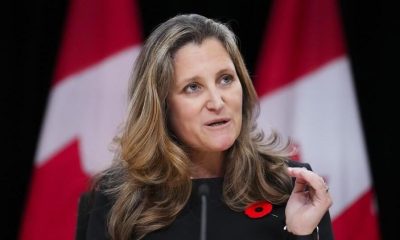Economy
FIRST READING: Canada’s not-great economy takes a turn for the worse
We’re in recession, immigration is swamping job growth, and disaffected newcomers are leaving

On Oct. 31, Statistics Canada projected that the economy was set to shrink by 0.1 per cent in the third quarter of 2023. Given that it already shrunk by 0.2 per cent last quarter, this means Canada is already well into six consecutive months of negative growth — the generally accepted definition of “recession.”
Canada is continuing to see meagre job growth. But any new jobs are immediately being overwhelmed by immigration numbers that remain at all-time highs.
An economic update released last month by Statistics Canada estimated that Canada added an average of 40,000 new jobs for each month of 2023. In each of those months, however, the working-age population surged by 78,000 — “almost twice the average increase in employment,” statisticians noted.
This means that in just the first eight months of 2023, Canada added 320,000 jobs, but also added 624,000 people looking for jobs. “With population growth outpacing employment gains, the employment rate … has edged lower,” wrote the statistics agency.
Immigration has been outpacing employment growth for several years now, but never anywhere close to the absurd disparities recorded in 2023.
In 2022, for instance, Canada added a monthly average of 34,000 new jobs against a monthly increase to the working population of just 41,000.
This trend has already manifested itself in some unbelievable scenes in parts of Ontario, with hundreds of workers seen queuing for a chance at a minimum wage retail job.
In Waterloo, Ont., last week, a Dollarama posted a listing for an “assistant team leader” and was swamped with nearly 2,000 applications, according to a screenshot on reddit. In early October, Toronto’s Dufferin Mall held a job fair for seasonal and entry-level retail jobs — and saw lineups of applicants stretch out the door and around the block.
On Tuesday, a new report by the Institute for Canadian Citizenship confirmed a trend that has been showing up in polls and surveys of new immigrants since at least the end of the pandemic: Spiking rates of immigrants are abandoning Canada to immigrate somewhere else.
The study’s most recent data on “onward migration” came from 2019, when the economy was on firmer ground and the immigration rate was less than half its current totals.
But even then, the rate of new Canadians leaving for greener pastures was “31 per cent higher than the historical average of 0.9 per cent.”
“After giving Canada a try, growing numbers of immigrants are saying ‘no thanks,’ and moving on,” read an introduction by Institute of Canadian Citizenship CEO Daniel Bernhard.
Forecasts for the Canadian economy were not particularly optimistic at the beginning of 2023. Even if Canadian GDP growth was still technically keeping its head above water, the country has been in a per-capita recession since mid-2022.
In the first months of 2023, the economy was still growing by fractions of a per cent each quarter. But with Canada now absorbing more than one million new people each year, each Canadian’s individual share of the economic pie has continued to shrink.
Western Canada had experienced a severe drought, which might have explained a slowdown in the agricultural sector. But analysts were less able to explain why manufacturing, retail and basically every other economic sector lost ground.
And the numbers got particularly dire when looking at GDP per capita, one of the indicators that most accurately portrays the individual Canadian’s experience of the economy.
The National Bank of Canada noted that in the third quarter of 2023, GDP per capita plunged 2.4 per cent as compared to the year prior. “The first time this has occurred outside of a recession,” they wrote.
In tandem with all of this, meanwhile, is that Canadians are seeing dropping employment and incomes at precisely the time when almost everything is getting dramatically more expensive.
This is most true of rents. Rents in Canada’s major cities are already among the world’s highest, with an average one-bedroom in Vancouver now going for an average of $2,976 per month. Even when accounting for cheaper markets, however, the average Canadian one-bedroom is still topping out at $1,889.
According to the most recent numbers from Rentals.ca, rents are now climbing by 11.1 per cent per year, meaning the average one-bedroom renter is now seeing their rent climb by at least $17 per month — and $21 for a two-bedroom renter.
And of all Canada’s gloomy economic indicators, real estate has some of the least hope of relief. Homebuilding – which hasn’t come close to meeting demand for at least a generation — is now declining, according to the most recent figures from Statistics Canada.
And with immigration growth well on track to hit the 1.1 million mark posted in 2022, each day is yielding an average of 3,000 new people into the Canadian real estate market.

Canada can’t maintain even our lacklustre status quo of military readiness, but we can fill our military installations with rising numbers of homeless people. After the Trudeau government hinted earlier this year that it would never, ever meet NATO’s two-per-cent-of-GDP baseline for defence spending, in September it then announced a further $1 billion cut to the Defence Department budget. But the City of Toronto has a plan for all that underfunded defence infrastructure: A recent motion called on the federal government to transform its five Greater Toronto Area armouries into homeless shelters and refugee processing facilities.

Roughly every few days sees another past or present parliamentarian calling for Prime Minister Justin Trudeau’s resignation. Former Conservative cabinet minister Joe Oliver did it Wednesday in the National Post, which isn’t overly surprising. But a slightly more unusual example was longtime Liberal stalwart Percy Downe, who currently serves as a Liberal-appointed Senator for Prince Edward Island. In an opinion piece for National Newswatch, Downe (a former chief of staff to Jean Chrétien) said that only if Trudeau is out of the picture will “Liberals have a chance of being reelected.”

In a Parliament Hill scrum on Tuesday, Trudeau said that his government will “absolutely” not consider any more carve-outs to the carbon tax. So it’s only home heating oil: Gasoline, diesel, butane, aviation fuel, coke, coal, ethane, kerosene, methanol, naphtha, propane and refinery gas will still pay the tax, which is set for its next increase on April 1.

Economy
Canada’s unemployment rate holds steady at 6.5% in October, economy adds 15,000 jobs

OTTAWA – Canada’s unemployment rate held steady at 6.5 per cent last month as hiring remained weak across the economy.
Statistics Canada’s labour force survey on Friday said employment rose by a modest 15,000 jobs in October.
Business, building and support services saw the largest gain in employment.
Meanwhile, finance, insurance, real estate, rental and leasing experienced the largest decline.
Many economists see weakness in the job market continuing in the short term, before the Bank of Canada’s interest rate cuts spark a rebound in economic growth next year.
Despite ongoing softness in the labour market, however, strong wage growth has raged on in Canada. Average hourly wages in October grew 4.9 per cent from a year ago, reaching $35.76.
Friday’s report also shed some light on the financial health of households.
According to the agency, 28.8 per cent of Canadians aged 15 or older were living in a household that had difficulty meeting financial needs – like food and housing – in the previous four weeks.
That was down from 33.1 per cent in October 2023 and 35.5 per cent in October 2022, but still above the 20.4 per cent figure recorded in October 2020.
People living in a rented home were more likely to report difficulty meeting financial needs, with nearly four in 10 reporting that was the case.
That compares with just under a quarter of those living in an owned home by a household member.
Immigrants were also more likely to report facing financial strain last month, with about four out of 10 immigrants who landed in the last year doing so.
That compares with about three in 10 more established immigrants and one in four of people born in Canada.
This report by The Canadian Press was first published Nov. 8, 2024.
The Canadian Press. All rights reserved.
Economy
Health-care spending expected to outpace economy and reach $372 billion in 2024: CIHI

The Canadian Institute for Health Information says health-care spending in Canada is projected to reach a new high in 2024.
The annual report released Thursday says total health spending is expected to hit $372 billion, or $9,054 per Canadian.
CIHI’s national analysis predicts expenditures will rise by 5.7 per cent in 2024, compared to 4.5 per cent in 2023 and 1.7 per cent in 2022.
This year’s health spending is estimated to represent 12.4 per cent of Canada’s gross domestic product. Excluding two years of the pandemic, it would be the highest ratio in the country’s history.
While it’s not unusual for health expenditures to outpace economic growth, the report says this could be the case for the next several years due to Canada’s growing population and its aging demographic.
Canada’s per capita spending on health care in 2022 was among the highest in the world, but still less than countries such as the United States and Sweden.
The report notes that the Canadian dental and pharmacare plans could push health-care spending even further as more people who previously couldn’t afford these services start using them.
This report by The Canadian Press was first published Nov. 7, 2024.
Canadian Press health coverage receives support through a partnership with the Canadian Medical Association. CP is solely responsible for this content.
The Canadian Press. All rights reserved.
Economy
Trump’s victory sparks concerns over ripple effect on Canadian economy

As Canadians wake up to news that Donald Trump will return to the White House, the president-elect’s protectionist stance is casting a spotlight on what effect his second term will have on Canada-U.S. economic ties.
Some Canadian business leaders have expressed worry over Trump’s promise to introduce a universal 10 per cent tariff on all American imports.
A Canadian Chamber of Commerce report released last month suggested those tariffs would shrink the Canadian economy, resulting in around $30 billion per year in economic costs.
More than 77 per cent of Canadian exports go to the U.S.
Canada’s manufacturing sector faces the biggest risk should Trump push forward on imposing broad tariffs, said Canadian Manufacturers and Exporters president and CEO Dennis Darby. He said the sector is the “most trade-exposed” within Canada.
“It’s in the U.S.’s best interest, it’s in our best interest, but most importantly for consumers across North America, that we’re able to trade goods, materials, ingredients, as we have under the trade agreements,” Darby said in an interview.
“It’s a more complex or complicated outcome than it would have been with the Democrats, but we’ve had to deal with this before and we’re going to do our best to deal with it again.”
American economists have also warned Trump’s plan could cause inflation and possibly a recession, which could have ripple effects in Canada.
It’s consumers who will ultimately feel the burden of any inflationary effect caused by broad tariffs, said Darby.
“A tariff tends to raise costs, and it ultimately raises prices, so that’s something that we have to be prepared for,” he said.
“It could tilt production mandates. A tariff makes goods more expensive, but on the same token, it also will make inputs for the U.S. more expensive.”
A report last month by TD economist Marc Ercolao said research shows a full-scale implementation of Trump’s tariff plan could lead to a near-five per cent reduction in Canadian export volumes to the U.S. by early-2027, relative to current baseline forecasts.
Retaliation by Canada would also increase costs for domestic producers, and push import volumes lower in the process.
“Slowing import activity mitigates some of the negative net trade impact on total GDP enough to avoid a technical recession, but still produces a period of extended stagnation through 2025 and 2026,” Ercolao said.
Since the Canada-United States-Mexico Agreement came into effect in 2020, trade between Canada and the U.S. has surged by 46 per cent, according to the Toronto Region Board of Trade.
With that deal is up for review in 2026, Canadian Chamber of Commerce president and CEO Candace Laing said the Canadian government “must collaborate effectively with the Trump administration to preserve and strengthen our bilateral economic partnership.”
“With an impressive $3.6 billion in daily trade, Canada and the United States are each other’s closest international partners. The secure and efficient flow of goods and people across our border … remains essential for the economies of both countries,” she said in a statement.
“By resisting tariffs and trade barriers that will only raise prices and hurt consumers in both countries, Canada and the United States can strengthen resilient cross-border supply chains that enhance our shared economic security.”
This report by The Canadian Press was first published Nov. 6, 2024.
The Canadian Press. All rights reserved.
-

 News20 hours ago
News20 hours agoFreeland says she’s ready to deal with Trump |
-

 News20 hours ago
News20 hours agoNASA astronauts won’t say which one of them got sick after almost eight months in space
-

 News20 hours ago
News20 hours ago43 monkeys remain on the run from South Carolina lab. CEO thinks they’re having an adventure
-

 News21 hours ago
News21 hours agoFreeland rallies a united front ahead of Trump’s return to White House
-

 News21 hours ago
News21 hours agoDeputy minister appointed interim CEO of AIMCo after Alberta government fires board
-

 News21 hours ago
News21 hours agoMontreal says Quebec-Canada dispute stalling much-needed funding to help homeless
-

 News20 hours ago
News20 hours agoS&P/TSX composite index down Friday, Wall St. extends post-election gains
-

 News20 hours ago
News20 hours agoMitch Marner powers Matthews-less Maple Leafs over Red Wings





















